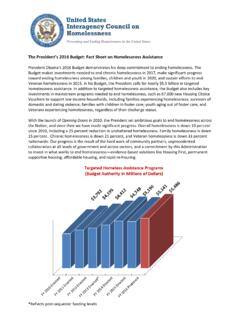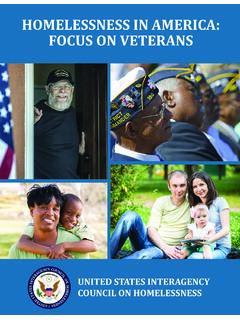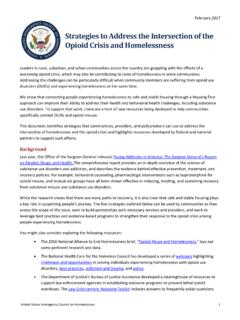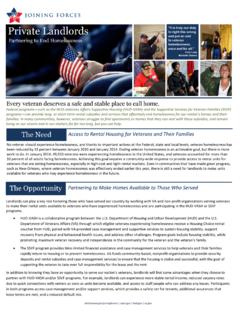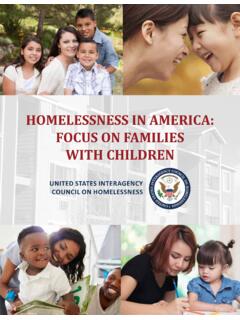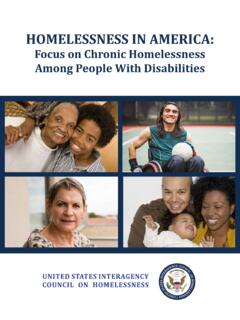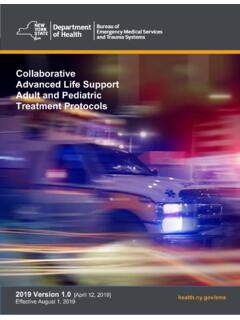Transcription of The Evidence Behind Approaches that Drive an End to ...
1 December 2017 United States Interagency Council on Homelessness 1 The Evidence Behind Approaches that Drive an End to Homelessness Housing stability is essential for people to address their challenges and pursue their goals. Housing and income are core social determinants of personal health, along with the circumstances under which people are born, grow up, live, work, age, and access health care. Substantial Evidence indicates that when people both adults and children alike experience homelessness, their prospects for future educational attainment, employment growth, health stability, and family preservation are significantly reduced. The lack of a safe and stable home also results, for some people, in increased use of crisis services, like shelter, emergency departments, detox programs, and psychiatric institutions, and greater engagement with other systems, like child welfare and criminal and juvenile justice, creating significant, preventable costs for public programs.
2 To reduce these impacts and end homelessness as quickly and efficiently as possible, communities are increasingly focused on using Evidence -based practices to streamline connections to housing opportunities and to provide people with the appropriate level of services to support their long-term housing stability. This shift in focus to permanent housing outcomes, driven by research on effective practices, has helped reduce homelessness nationwide by 13% between 2010 and 2017, according to annual Point-in-Time counts. Shifting to Housing First To improve housing outcomes, communities are making a fundamental shift to Housing First, removing as many obstacles and unnecessary requirements as possible that stand in the way of people s access to permanent housing.
3 They are also developing coordinated systems with multiple entry points and standardized Approaches to assessment in order to streamline people s ability to access needed housing resources and programs including mainstream programs like workforce services, early childhood education, schools, health and behavioral health care programs, affordable housing, and others. Effective Housing First Approaches , developed in response to strong Evidence , include: prioritizing people experiencing homelessness for new and existing affordable housing; providing rapid re-housing to families and individuals; and providing supportive housing opportunities to people with the most intense needs. Prioritizing People Experiencing Homelessness for New and Existing Affordable Housing Research indicates that affordability is a key determinant of the future stability of a household s housing.
4 With support of federal and national partners, communities have focused greater attention on targeting and prioritizing people experiencing homelessness for existing or new affordable housing opportunities. Some jurisdictions are also working to remove local barriers to housing development and to invest in an expanded supply of affordable housing, informed by Evidence that these efforts will: Create wide-ranging positive impacts for adults and children: HUD s large-scale Family Options Study demonstrated that access to affordable housing reduces food insecurity and improves adult and child well-being and long-term housing stability. In another study, children living in subsidized housing were more likely to be food secure, less likely to be seriously underweight, and more likely to be classified as well on a composite indicator of child health, compared to their peers whose families were on the wait list for subsidized housing.
5 December 2017 United States Interagency Council on Homelessness 2 Strengthen family well-being and reduce violence and insecurity: Access to a permanent subsidy leads to dramatic reductions in child separations, domestic violence, psychological distress, food insecurity, and school mobility. Providing rapid Re-Housing to Families and Individuals rapid re-housing interventions assist individuals and families experiencing homelessness to return to permanent housing as quickly as possible, through housing identification, rent and move-in assistance, and case management. rapid re-housing may be combined with some models of time-limited, bridge, or transitional housing to facilitate connections to permanent housing, especially for some subpopulations.
6 Communities focus on expanding the availability of rapid re-housing opportunities is supported by research that suggests: rapid re-housing costs significantly less than other housing interventions. The Family Options Study found the average program cost for rapid re-housing was $6,578, compared with $16,829 for emergency shelter, $18,821 for a permanent subsidy, and $32,557 for transitional housing. It leads to high rates of placement into permanent housing. For Supportive Services for Veteran Families (SSVF) households receiving rapid re-housing or prevention services, 80% had permanent housing upon program exit. An even higher proportion (90%) of families in the rapid Re-housing for Homeless Families Demonstration (RRHD) evaluation exited the program with a housing placement.
7 It increases family self-sufficiency. One-quarter of Veterans with no income upon entry into the SSVF program left with some amount of monthly income. HUD s Family Options Study showed statistically significant increases in total family income and decreases in food insecurity compared to usual care. Providing Supportive Housing Opportunities to People with the Most Intense Needs Supportive housing combines non-time-limited affordable housing assistance with wrap-around supportive services for individuals and families with the longest histories of homelessness and disabilities. When operated with Housing First practices, there are few or no preconditions for entry, such as sobriety, absence of a criminal record, or medication adherence.
8 While participation in services is encouraged, it is not a condition of housing. Studies of supportive housing show: Communities spent less on shelters, jails, ambulances, and emergency rooms. Over more than a decade, dozens of studies across the country show that the costs of delivering supportive housing are offset entirely or in large part by reductions in the use of crisis , 2, 3, 4, 5 Participants were much less likely to return to homelessness. Evaluations of supportive housing programs generally show housing retention rates even among tenants with the longest histories of homelessness and the most complex needs between 75-85% for single adults and between 80-90% for families. Research and Evidence have fundamentally changed how communities are responding to the crisis of homelessness and those changes are driving substantial progress.
9 We are committed to using future research and emerging Evidence to strengthen our efforts to support communities to implement the best and strongest practices. 1 2 Sadowski, L., et al. 2009. Effect of a Housing and Case Management Program on Emergency Department Visits and Hospitalizations Among Chronically Homeless Adults. JAMA 301 (17), 1771-1778; Basu A., et al. 2012. Comparative Cost Analysis of Housing and Case Management Program for Chronically Ill Homeless Adults Compared to Usual Care. Journal of Health Services Research. DOI: 3 Hall Gerod, et al. 2014. Public Service Use and Costs Associated with NY/NY III s Supportive Housing for Active Substance Users.
10 Columbia University, The National Center on Addiction and Substance Abuse. 4 5
